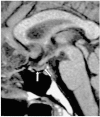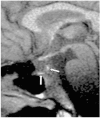MR imaging of central diabetes insipidus: a pictorial essay
- PMID: 11754330
- PMCID: PMC2718125
- DOI: 10.3348/kjr.2001.2.4.222
MR imaging of central diabetes insipidus: a pictorial essay
Abstract
Central diabetes insipidus (DI) can be the outcome of a number of diseases that affect the hypothalamic-neurohypophyseal axis. The causes of the condition can be classified as traumatic, inflammatory, or neoplastic. Traumatic causes include postoperative sella or transection of the pituitary stalk, while infectious or inflammatory causes include meningitis, lymphocytic hypophysitis, and granulomatous inflammations such as sarcoidosis and Wegener's granulomatosis. Various neoplastic conditions such as germinoma, Langerhans cell histiocytosis, metastasis, leukemic infiltration, lymphoma, teratoma, pituitary adenoma, craniopharyngioma, Rathke cleft cyst, hypothalamic glioma, and meningioma are also causes of central DI. In affected patients, careful analysis of these MR imaging features and correlation with the clinical manifestations can allow a more specific diagnosis, which is essential for treatment.
Figures













Similar articles
-
The diagnosis of children with central diabetes insipidus.J Pediatr Endocrinol Metab. 2007 Mar;20(3):359-75. doi: 10.1515/jpem.2007.20.3.359. J Pediatr Endocrinol Metab. 2007. PMID: 17451074 Review.
-
Posterior pituitary gland: appearance on MR images in normal and pathologic states.Radiology. 1987 Nov;165(2):481-5. doi: 10.1148/radiology.165.2.3659370. Radiology. 1987. PMID: 3659370
-
Serial T1-weighted magnetic resonance imaging changes in a patient with central diabetes insipidus, possibly due to lymphocytic infundibuloneurohypophysitis.Eur J Endocrinol. 2005 Dec;153(6):989-90. doi: 10.1530/eje.1.02043. Eur J Endocrinol. 2005. PMID: 16322406 No abstract available.
-
Central diabetes insipidus in children and young adults.N Engl J Med. 2000 Oct 5;343(14):998-1007. doi: 10.1056/NEJM200010053431403. N Engl J Med. 2000. PMID: 11018166
-
Diabetes insipidus--diagnosis and management.Horm Res Paediatr. 2012;77(2):69-84. doi: 10.1159/000336333. Epub 2012 Mar 16. Horm Res Paediatr. 2012. PMID: 22433947 Review.
Cited by
-
Clinical management of teratoma, a rare hypothalamic-pituitary neoplasia.Endocrine. 2016 Sep;53(3):636-42. doi: 10.1007/s12020-015-0814-4. Epub 2015 Dec 23. Endocrine. 2016. PMID: 26701679 Review.
-
A case of pituitary metastasis discovered when diabetes insipidus developed in a patient 20 years after breast cancer treatment.Radiol Case Rep. 2023 Aug 26;18(11):3904-3907. doi: 10.1016/j.radcr.2023.08.025. eCollection 2023 Nov. Radiol Case Rep. 2023. PMID: 37670924 Free PMC article.
-
Case Report: Ipilimumab-Induced Panhypophysitis: An Infrequent Occurrence and Literature Review.Front Oncol. 2020 Dec 1;10:582394. doi: 10.3389/fonc.2020.582394. eCollection 2020. Front Oncol. 2020. PMID: 33335854 Free PMC article.
-
Rathke's cleft cyst: From history to molecular genetics.Rev Endocr Metab Disord. 2025 Apr;26(2):229-260. doi: 10.1007/s11154-025-09949-6. Epub 2025 Feb 13. Rev Endocr Metab Disord. 2025. PMID: 39939491 Free PMC article. Review.
-
Late magnetic resonance imaging findings in trauma-induced central diabetes insipidus: Case report and review of literature.Radiol Case Rep. 2021 Apr 17;16(6):1514-1517. doi: 10.1016/j.radcr.2021.03.048. eCollection 2021 Jun. Radiol Case Rep. 2021. PMID: 33981375 Free PMC article.
References
-
- Ozata M, Tayfun C, Kurtaran K, et al. Magnetic resonance imaging of posterior pituitary for evaluation of the neurohypophyseal function in idiopathic and autosomal dominant neurohypophyseal diabetes insipidus. Eur Radiol. 1997;7:1098–1102. - PubMed
-
- Ma L, Gao Y, Cai Y, Li T, Liang Y. MR evaluation of the brain in central diabetes insipidus. Chin Med J. 1996;109:724–729. - PubMed
-
- Black PM, Zervas NT, Candia GL. Incidence and management of complications of transsphenoidal operation for pituitary adenomas. Neurosurgery. 1987;20:920–924. - PubMed
Publication types
MeSH terms
LinkOut - more resources
Full Text Sources
Medical

